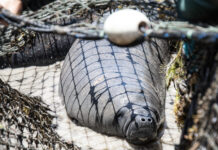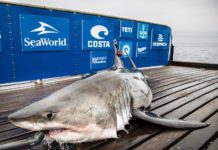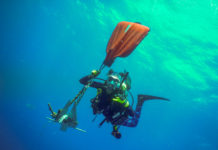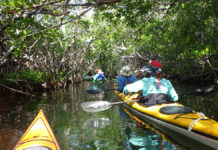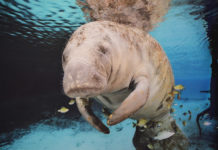
For a few days there, every thing was fine — calm winds, flat seas, and sunshine gave everyone an opportunity to get out and enjoy everything our Florida Keys waters have to offer. The billfish flags have been flying as more and more sailfish are showing up each day. Wahoo and dolphin are being caught offshore and the bite on the reef has been nonstop. Overall, fishing has been great!
I had the opportunity to fish with Capt. Mike Biffel of Big Dawg Sportfishing this week, and we were able to put a nice catch together of wahoo and dolphin. We started our morning trolling around with live bonitas. Even though our bait looked great, nothing seemed to bite, so we switched to plan B. We put out some wahoo lures, and trolled around at various depths. That still proved unsuccessful, so went on to plan C. We decided to put out some smaller lures (billy baits) and troll those around. Finally, success! We hooked a wahoo right away. The second the fish struck, we switched over to live pilchards hoping we would entice more wahoo to bite. By the end of the day, we ended up catching four wahoos between 20 and 50 pounds and some nice mahi-mahis. The morale to my little fishing story is, don’t get discouraged if the fish don’t bite. Keep changing your bait and techniques until you find what works. Fish can be picky eaters, and you never know what’s going to work on any given day.
The sailfish bite is heating up. There are different methods for targeting sailfish at different depths of water. When sailfish are in shallow, between 25 to 100 feet of water, they’re normally there chasing ballyhoo around. Your bait of choice in that area would be live ballyhoo with a 30 to 40 pound leader. You’ll also find packs of dolphin traveling in the same area, feeding on the ballyhoo under the frigate birds. This time of year, you can use the same rig for both pelagic species.
If nothing is really biting in the shallow waters, you can move deeper and try to catch sailfish using a different method. Put some live baits out and drift around. Baits like pilchards, cigar minnows and ballyhoo are perfect for this method of fishing. This technique will also target multiple species of fish, such as tuna, dolphin, bonita, kingfish, wahoo and sailfish.
On the wrecks, there has been plenty of action. Mutton snapper, amberjacks and kingfish have all been biting. To target these species, you can use any kind of live bait with a 15 to 20 foot leader, and a 6 to 8 ounce sinker. The idea is to get your bait up current of the wreck and drift over it, with your live baits swimming along the bottom. While drifting along the wreck, your depthfinder may mark some fish in the upper water columns. Vertical jigs and live bait chumning will get those particular fish biting. Another method is to hook a pilchard in the belly on a pitching rod and cast it out. This will make the bait swim down a little, 40-50 feet, which is right where those fish will be swimming though. Kingfish and wahoo also tend to hang out around these wrecks, so always have a steel leader ready to pitch in case you notice some lines being bitten off.
On the patch reefs, large mangrove snapper bite continues to be spectacular. Most of our big fish were caught fishing with pilchards and live ballyhoo on jig heads between 20 and 40 feet of water. When you’re fishing the patch reefs match the weight of your jigs to the current and the depths. You don’t want your bait just lying on bottom, nor do you want it swimming up and out of the bite zone. Take a variety of jig sizes out with you, and adjust accordingly.



















